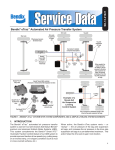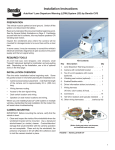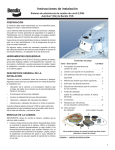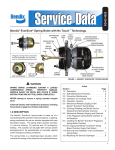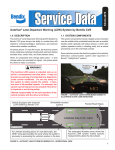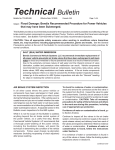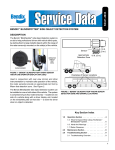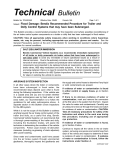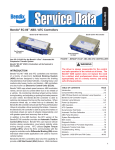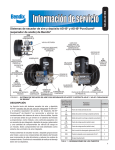Download BENDIX BW2598 User's Manual
Transcript
SD-13-4861 Bendix® ATR-6™ and ATR-3™ Antilock Traction Relay Valves Bendix® ATR-3™ Antilock Traction Relay Valves 2 PIN SOLENOID CONNECTOR CONTROL SOLENOID CONTROL PORT COVER Bendix® ATR-6™ Antilock Traction Relay Valves SUPPLY PORT DELIVERY PORTS (6) FIGURE 1 - BENDIX® ATR-6™ (AND ATR-3™) ANTILOCK TRACTION RELAY VALVES DESCRIPTION This Service Data sheet covers the operation, and replacement procedures, for both the Bendix® ATR-6™ and the previous ATR-3™ Antilock Traction Relay valves. These valves are specialized air brake valves developed for use on Bendix antilock/traction-equipped vehicles. This document will refer to the ATR-6™ Antilock Traction Relay valve throughout since the ATR-3™ version operates in an almost identical way. See Figure 1 for external differences. The ATR-6™ Antilock Traction Relay valve is a service relay valve fitted with a modified cover containing a Control Solenoid. It contains both air and electric components to provide the service braking and traction control (differential braking) as well as ESP® advanced stability system ABS functions. Typically the ATR-6™ valve replaces a standard relay valve used to control the rear axle service brakes, though it may be used for both front and rear axles on some advanced ABS vehicle applications. In normal operation, it performs the standard relay function and like the standard relay valve it replaces, the ATR-6™ valve is normally mounted near the service brakes it serves. When the ABS Controller operates the ATR-6™ valve, for example during an antilock traction event, the Control ESP® is a registered trademark of Daimler and is used by BCVS under license. Solenoid is energized and permits delivery air to be supplied to the Antilock Modulator Valves and used as required by the Controller - see Operation below for a full explanation. For ease of servicing, the inlet/exhaust valve can be replaced without the need to remove the entire valve. All air connections on the ATR-6™ valve are identified as shown below. Bendix® ATR-6™ Antilock Traction Relay Valve AIR CONNECTION EMBOSSED IDENT. Supply (to reservoir) . . . . . . . . . . . . . . . . . SUP (1) Delivery (to brake chamber) . . . . . . . . . . DEL (2) Control (to brake valve rear delivery) . . CON (4) The ATR-6™ valve is part of the R-12™ family of relay valves. The internal components of the relay portion of all of these valves are interchangeable with the R-12™ valve and the same basic components are used to service all of them. The ATR-6™ valve is available with various crack pressures (the control pressure required to initiate air delivery to the brakes) to accommodate specific vehicle applications; however the standard is 4 psi (see Figure 7 on Page 5). Control Shuttle. The small piston (shown in its normal rest position). The arrow indicates spring force holding it in position. BRAKE PEDAL CONTROL SOLENOID CONTROL PORT RELAY VALVE PISTON SUPPLY PORT DELIVERY PORT ANTILOCK MODULATOR VALVE INLET / EXHAUST VALVE BRAKE CHAMBER RESERVOIR VALVE EXHAUST WHEEL SPEED SENSOR TONE RING Diagram shows a rear brake application, but this valve may also be used for front brakes FIGURE 2 - SECTIONAL ATR-6™ ANTILOCK TRACTION ASSEMBLY OPERATION GENERAL See Figure 2. The ATR-6™ Antilock Traction Relay valve is a service relay valve fitted with a modified cover containing a Control Solenoid. Under normal operating conditions the Control Shuttle, a small piston within the traction solenoid, remains in its rest position, held by spring pressure. The driver applies the brakes. The piston in the relay valve moves down allowing the waiting air pressure to pass to the brake chambers ANTILOCK EVENTS This document will describe the use of the ATR-6™ valve when used during a traction control event, although this is only one role for which this valve is used. Advanced Bendix ABS systems also use this valve to help supply specific braking delivery for ABS events at a wider range of speeds than typical traction control events occur, however the process of energizing the solenoid and delivery of air is the same. RESERVOIR BRAKE APPLICATION See Figure 3. During normal braking, as the driver applies force to the brake pedal, air pressure is delivered from the brake pedal to the relay valve control port. The air pressure passes into the valve, past the Control Shuttle, and moves the relay valve piston down. The piston pushes down and contacts the exhaust seat of the inner (or ‘exhaust’) portion of the inlet/exhaust valve, sealing off the exhaust passage. As the piston moves further down, the outer (or ‘inlet’) portion of the inlet/exhaust valve moves off its seat, permitting supply air from the reservoir to flow past the open inlet valve, and into the service brake chambers. 2 BRAKE CHAMBER FIGURE 3 - SERVICE BRAKE APPLICATION BALANCE See Figure 4. The air pressure being delivered by the open inlet valve also is effective on the bottom area of the relay piston. When air pressure beneath the piston equals the service air pressure above, the piston lifts slightly and the inlet spring returns the inlet valve to its seat. The exhaust remains closed as the service line pressure balances the delivery pressure. As delivered air pressure is changed, the valve reacts instantly to the change, holding the brake application at that level. The pressure under the piston equals the pressure above. The piston lifts slightly - the exhaust remains closed. FIGURE 4 - BRAKE APPLICATION HOLDING EXHAUST (OR RELEASE) See Figure 5. When the driver releases the brake pedal, air pressure above the relay piston is exhausted at the brake valve exhaust. At the same time, air pressure beneath the piston lifts the relay piston and the exhaust seat moves away from the exhaust valve, opening the exhaust passage at the base of the relay valve. With the exhaust passage open, the air pressure from the brake chambers passes to the Antilock Modulator Valve exhaust port, releasing the brakes, and air pressure between the relay valve and the modulator is released at the relay valve exhaust port. The driver releases the brakes. The piston in the relay valve moves up, closing the delivery, and opening the exhaust. FIGURE 5 - BRAKE RELEASE The small piston moves to its energized position. The arrow indicates the direction it moves. The antilock traction Controller energizes the solenoid, applying full reservoir pressure to the antilock modulators. The Controller selects the antilock modulator to deliver air to the brake chamber TRACTION CONTROL The ABS Controller monitors the driver’s accelerator application, as well as the vehicle’s motion using wheel speed sensors. When the vehicle is stopped, or moving at any speed up to 25 mph and the Controller detects wheel spin, for example where one wheel is slipping on an icy patch, the ABS Controller will intervene to assist the vehicle’s traction. The ABS Controller obtains braking power for the traction intervention by energizing the Control Solenoid in the ATR-6™ valve. This causes the traction piston to move to its secondary position, allowing the supply air to operate the relay piston and supply air pressure to each of its Antilock Modulator Valves as shown in Figure 6. The Controller then operates (opens and closes) the solenoid valves in the individual Antilock Modulator Valve for each spinning (slipping) wheel to slow that wheel. As the FIGURE 6 - TRACTION APPLICATION spinning wheel slows down, it forces the vehicle differential to drive the other stationary, or slowly-turning wheel on that axle, aiding the vehicle in gaining traction. Note: in some vehicle arrangements a single modulator valve may control air delivery to more than one brake chamber. 3 For a full description of antilock operation refer to the appropriate Service Data Sheet covering the Electronic Controller used on the vehicle. (Note: Service Data Sheets are available for download from www.bendix.com.) 5. Following the vehicle manufacturer’s recommended procedures, deactivate the electrical system in a manner that safely removes all electrical power from the vehicle. PREVENTIVE MAINTENANCE 6. Never exceed manufacturer ’s recommended pressures. Important: Review the Bendix Warranty Policy before performing any intrusive maintenance procedures. A warranty may be voided if intrusive maintenance is performed during the warranty period. No two vehicles operate under identical conditions, as a result, maintenance intervals may vary. Experience is a valuable guide in determining the best maintenance interval for air brake system components. At a minimum, the valve should be inspected every 6 months or 1500 operating hours, whichever comes first, for proper operation. Should the valve not meet the standards of the operational tests noted in this document, further investigation and service of the valve may be required. GENERAL SAFETY GUIDELINES 7. Never connect or disconnect a hose or line containing pressure; it may whip. Never remove a component or plug unless you are certain all system pressure has been depleted. 8. Use only genuine Bendix ® replacement parts, components and kits. Replacement hardware, tubing, hose, fittings, etc. must be of equivalent size, type and strength as original equipment and be designed specifically for such applications and systems. 9. Components with stripped threads or damaged parts should be replaced rather than repaired. Do not attempt repairs requiring machining or welding unless specifically stated and approved by the vehicle and component manufacturer. WARNING! PLEASE READ AND FOLLOW THESE INSTRUCTIONS TO AVOID PERSONAL INJURY OR DEATH: 10. Prior to returning the vehicle to service, make certain all components and systems are restored to their proper operating condition. When working on or around a vehicle, the following general precautions should be observed at all times. 11. For vehicles with Antilock Traction Control (ATC), the ATC function must be disabled (ATC indicator lamp should be ON) prior to performing any vehicle maintenance where one or more wheels on a drive axle are lifted off the ground and moving. 1. Park the vehicle on a level surface, apply the parking brakes, and always block the wheels. Always wear safety glasses. 2. Stop the engine and remove ignition key when working under or around the vehicle. When working in the engine compartment, the engine should be shut off and the ignition key should be removed. Where circumstances require that the engine be in operation, EXTREME CAUTION should be used to prevent personal injury resulting from contact with moving, rotating, leaking, heated or electrically charged components. 3. Do not attempt to install, remove, disassemble or assemble a component until you have read and thoroughly understand the recommended procedures. Use only the proper tools and observe all precautions pertaining to use of those tools. 4. If the work is being performed on the vehicle’s air brake system, or any auxiliary pressurized air systems, make certain to drain the air pressure from all reservoirs before beginning ANY work on the vehicle. If the vehicle is equipped with an AD-IS® air dryer system or a dryer reservoir module, be sure to drain the purge reservoir. VEHICLE PREPARATION 1. Park the vehicle on a level surface and block the wheels and/or hold the vehicle by means other than the air brakes. 2. Drain the air pressure from all vehicle reservoirs. REMOVAL AND INSTALLATION Identify and mark or label all electrical wiring harnesses and air hoses and their respective connections on the assembly to facilitate ease of installation. REMOVAL 1. If the entire valve is to be removed, identify air hoses to facilitate installation. Prior to disassembly, remove as much contamination as possible from the exterior of the device taking care to keep all contamination from entering the open ports. 2. Disconnect air hoses from valve*. 3. Disconnect the electrical connector from the traction solenoid. 4. Remove valve from reservoir or if remotely mounted, remove mounting bolts and then valve. *It is generally not necessary to remove entire valve when servicing only the inlet/exhaust valve. The inlet/exhaust 4 Key No. 1 . 2 . 3 . 4 . 5 . 6 . 7 . 8 . 9 . 10. 11. 12. 13. 14. . . . . . . . . . . . . . . . . . . . . . . . . . . . . . . . . . . . . . . . . . . Washer Identifying Crack Pressure Description . . . . . . . . . . . . . . . Valve Cover . O-ring . O-ring . Relay Piston . Valve Body . Inlet & Exhaust Valve . Valve Retainer . Spring . O-ring . O-ring . Exhaust Cover . Retaining Ring . Differential Spring (If Used) . Sealing O-ring CAP SCREW TRACTION SOLENOID 1 2 3 See Below for O-ring Identification Chart 13 DIFFERENTIAL SPRING (CONTROLS CRACK PRESSURE*) (Not used for most models. See box below.) 4 14 5 HORIZONTAL DELIVERY PORTS DIFFERENTIAL SPRINGS *Crack Pressure is the amount of control pressure required by the valve to initiate air delivery. For Crack Pressures other than 4 psi, a differential spring is used in the assembly to produce the required valve response. (Models designed to have a 4 psi Crack Pressure do not require a differential spring.) SUPPLY PORT 6 VERTICAL DELIVERY PORTS 7 8 9 O-RING IDENTIFICATION SECTIONAL SIDE VIEW SHOWING HOW AN O-RING IS MEASURED. 10 11 I.D." 12 W O.D." Key I.D. O.D. 2 3.487 3.693 3 3.234 3.512 9 1.424 1.630 10 0.862 1.068 14 0.255 0.435 W 0.103 0.066 FIGURE 7 - ATR-6™ EXPLODED VIEW AND O-RING IDENTIFICATION 5 Caution: Drain all reservoirs before attempting to remove the inlet exhaust valve. Replace all parts not considered serviceable during these inspections and all springs and rubber parts. Use only genuine Bendix replacement parts, available from any authorized Bendix parts outlet. DISASSEMBLY ASSEMBLY Note: Prior to disassembly, mark the location of the mounting bracket (not shown) to the cover and the cover to the body. Note: All torques specified in this document are assembly torque and can be expected to fall off slightly after assembly. Do not re-torque after initial assembly torque fall. For assembly, hand wrenches are recommended. valve insert can be removed by removing the snap ring, exhaust cover assembly and then inlet/exhaust valve. CAUTION: The valve body may be lightly clamped in a bench vise during disassembly, however, over-clamping will result in damage to the valve and result in leakage and/or malfunction. If a vise is to be used, position the valve so that the jaws bear on the supply ports on opposing sides of the valve’s body. 1. Remove the four cap screws (and I.D. washer) securing the mounting bracket and cover to the body. Retain the cap screws and washer for reuse. Remove the electrical connection to the traction solenoid. Prior to assembly, lubricate all O-rings, O-ring bores and any sliding surface with a silicone lubricant equivalent to Dow Corning #10. Wash all remaining parts in mineral spirits and dry thoroughly. Using the lubricant provided in this kit, lightly lubricate all O-rings, O-ring grooves, body bores and any sliding surfaces. 1. Install O-rings (9 & 10) in the exhaust cover assembly (11). 2. Remove and discard sealing rings (2 and 14) from the cover (1). 2. Install O-ring (3) on the piston (4). 3. Remove piston (4) from the body (5) [and differential spring (13) if used]. Retain these items for reuse. 4. Install the retainer (7) on the inlet exhaust valve (6) and insert both in the body (5). 4. Remove and discard O-ring (3) from piston (4). 5. Install the spring (8) in the body (5). 5. Depress and hold the exhaust cover assembly (11) and remove and discard retaining ring (12) from the valve body (5). 6. Install the exhaust cover assembly (11) in the body (5). Depress and hold the exhaust cover assembly in the body. 6. Slowly release the holding force on the exhaust cover assembly (11) to relax the spring. 7. Install retaining ring (12) in the body (5). Make certain the retaining ring is completely seated in the groove in the body. 7. Remove and discard the following parts: a. Exhaust cover assembly (11) b. O-rings (9 & 10) c. Spring (8) d. Inlet exhaust valve (6) e. Retainer (7) CLEANING AND INSPECTION 1. Wash all metal parts in mineral spirits and dry them thoroughly. (Note: When servicing R-12® valves, all springs and all rubber parts should be replaced.) 2. Inspect all metal parts for deterioration and wear, as evidenced by scratches, scoring and corrosion. 3. Install the sealing rings (2 and 14) on the cover (1). 8. Install the piston (4) in the body (5). Where applicable, re-use the differential spring (13). 9. Referring to the marks made during disassembly, install the cover (1). 10. Install the mounting bracket (not shown) on the cover (1). 11. Install the four cap screws with the I.D. washer in the cover (1) and torque to 80-100 inch pounds. 12. Test the valve as outlined in the Operational and Leakage Test section before returning the vehicle to service. INSTALLATION 3. Inspect the exhaust valve seat on the relay piston for nicks and scratches which could cause excessive leakage. 1. Clean and inspect all air hoses for damage and replace as necessary. 4. Inspect the inlet valve seat in the body for scratches and nicks, which could cause excessive leakage. 3. Connect air hoses to the valve (plugging any unused ports). 5. Inspect the check valve seat in the R-12® valve cover and make sure all internal air passages in this area are open and clean and free of nicks and scratches. 4. Reconnect the wire harness to the traction solenoid using the identification made during REMOVAL step. 6 2. Install the valve and tighten mounting bolts. 5. Test valve as outlined in Operational and Leakage Tests. OPERATIONAL AND LEAKAGE TESTS 1. Chock the wheels, fully charge air brake system and adjust the brakes. 2. Make several brake applications and check for prompt application and release at each wheel. 3. Check for inlet valve and O-ring leakage. Make this check with the service brakes released. Coat the exhaust port and the area around the retaining ring with a soap solution; leakage of a one-inch bubble in 3 seconds is permitted. 4. Check for exhaust valve leakage. Make this check with the service brakes fully applied. Coat the outside of the valve where the cover joins the body to check for seal ring leakage; no leakage is permitted. If the valve does not function as described above, or if the leakage is excessive, it is recommended that the valve be replaced with new or remanufactured units or repaired with genuine Bendix parts, available at any authorized Bendix parts outlet. Refer to the Antilock Traction Controller Service Data sheet for operational test for traction functionality. GENERAL A change in vehicle braking characteristics or a low pressure warning may indicate a malfunction in one or the other brake circuit, and although the vehicle air brake system may continue to function, the vehicle should not be operated until the necessary repairs have been made and both braking circuits, including the pneumatic and mechanical devices, are operating normally. Always check the vehicle brake system for proper operation after performing brake work and before returning the vehicle to service. specified for the ATR-6™ valve’s part number (also shown on the I.D. washer installed on one of the cap screws). NOTE: For ATR-6™ valves not incorporating a relay piston return spring (13), the measured differential should be approximately 4 psi. When a spring is in use, the differential will be higher. 2. Disconnect the ATR-6 ™ valve’s two pin solenoid connector from the Controller wire harness. Apply the probes of a volt-ohm meter to the connector leading to the solenoid and note the resistance of the solenoid is between 15 and 17 ohms. If resistance other than this is found, replace the ATR-6™ valve. 3. Apply and remove vehicle power (12 VDC) to the two pin connector half leading to the ATR-6™ valve’s (solenoid) while observing the brake chambers. Note that a brake application is made and held while power is applied to the ATR-6™ valve’s solenoid and that it is released when power is removed. LEAKAGE TESTS 1. Build the air system pressure to governor cutout. Apply a soap solution to the exhaust port. The leakage noted should not exceed a one-inch bubble in less than 3 seconds. 2. Make and hold a full brake application and apply a soap solution to the exhaust port and around the cover where it joins the body. The leakage noted should not exceed a one-inch bubble in less than 3 seconds at the exhaust port. If the ATR-6™ valve fails to function as described, or leakage is excessive, it should be replaced with a new or genuine Bendix unit. OPERATION TEST BENDIX TECHNICAL ASSISTANCE TEAM 1. Apply and release the brakes several times and check for prompt application and release at each wheel. For direct telephone technical support, call the Bendix Tech Team at: If an incomplete or sluggish release of the brakes is noted at some, but not all wheels, test the Antilock Modulator Valve(s) operating those wheels for proper operation, and inspect for kinked or obstructed air hose leading to, or from, the Modulator(s). 1-800-AIR-BRAKE (1-800-247-2725), Monday through Friday, 8:00 A.M. to 6:00 P.M. EST, and follow the instructions in the recorded message. Or, you may e-mail: [email protected] If an incomplete or sluggish release is noted at all wheels, inspect for kinked or obstructed air hose leading to, or from, the ATR-6™ valve. Note: The ATR-6™ valve’s Crack Pressure differential can be checked by applying 10 psi to the service port and noting the pressure registered at the delivery port with a gauge of known accuracy. Subtract the delivery port pressure from the 10 psi service pressure to obtain the differential. Compare the measured differential with the Crack Pressure 7 8 BW2598 © 2008 Bendix Commercial Vehicle Systems LLC. All Rights Reserved. 4/08 Printed in U.S.A.








